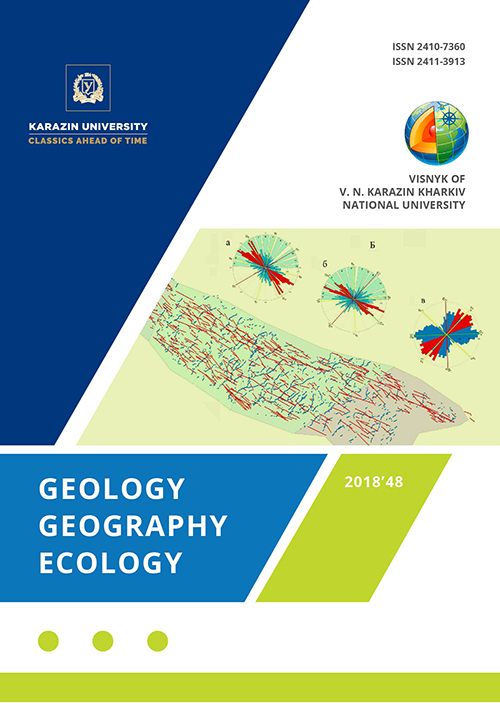Конструктивно-географічне значення досліджень ландшафтно-технічних систем
DOI:
https://doi.org/10.26565/2410-7360-2018-48-10Ключові слова:
ландшафтно-технічна система, розвиток, стадія, критерії, оцінка, блокова структура, контроль, оптимізаціяАнотація
У статті запропоновано розробку універсального алгоритму досліджень ландшафтно-технічних систем. Зазначено, що кожен етап таких досліджень передбачає детальний аналіз блокової структури ландшафтно-технічної системи та її взаємозв’язків з навколишнім середовищем. Оптимальною є діяльність експертної групи з чотирьох дослідників, з яких – три особи (фахівці у галузях народного господарства) аналізуватимуть блоки, а одна особа (інженер-ландшафтознавець) координуватиме їх дії. Перший етап досліджень полягає в оцінці стану кожного окремого блоку ландшафтно-технічної системи (блоку управління, технічного блоку і природного блоку). Другий етап досліджень передбачає ідентифікацію стадії розвитку ландшафтно-технічної системи. На третьому етапі здійснюється вибір можливого подальшого розвитку ландшафтно-технічної системи. Загалом, розроблено шість варіантів розвитку, кожен з яких зорієнтований на активність контролю з боку блоку управління. На останньому етапі досліджень розпочинається оптимізація, під час якої здійснюється комплекс заходів, спрямованих на відновлення роботи ландшафтно-технічної системи. Зроблено висновок про те, що у подібних дослідженнях першочергова роль відводиться інженерам-ландшафтознавцям, оскільки від їхніх універсальних знань, умінь та навичок залежатиме майбутня життєдіяльність ландшафтно-технічних систем.Посилання
Denysyk, G. I. (1998). Antropogenіc landscape of Right-Bank Ukraine. Vinnytsa, 292 [in Ukrainian].
D’jakonov, K. N. (1978). Formation of the concept of the geotechnical systems. Questions of Geography. Nature management (geographical aspects), 108, 54–63 [in Russian].
Lavryk, O. D. (2017). Identification of stages of development of landscape and technical systems. Visnyk of V. N. Karazin Kharkiv National University. Series: Geology. Geography. Ecology, 46, 101–105 [in Ukrainian].
Lavryk, O. D. (2016). Landscape study engineering: modern situation and prospects of development. Scientific notes of Vinnitsa State Pedagogical University named after Mikhailo Kotzubynsky. Series: Geography, 28 (1–2), 10–17 [in Ukrainian].
Lavryk, O. D. (2015). River landscape and technical systems. Uman, 301 [in Ukrainian].
Lozhkin, I. V. (2005). Geoecological assessment of soil transformation in natural and technical systems under the influence of urbanization (for example, Orenburg): Extended abstract of candidate’s thesis. Orenburg, 19 [in Russian].
Mil’kov, F. N. Antropogenіc landscape. The story of anthropogenic complexes. Moscow, 86 [in Russian].
Mil’kov, F. N. (1973). Man and landscapes. Essays anthropogenic landscape science. Moscow, 224 [in Russian].
Parmuzin, Ju. (1968). Landscape study engineering. Earth and people, 266–269 [in Russian].
Popov, A. P. (2005). Management of geotechnical systems of the gas complex in the permafrost zone: forecast of the state and reliability. Extended abstract of Doctor’s thesis. Tyumen, 48 [in Russian].
Preobrazhenskij, V. S. (Ed.). (1978). Nature, technology, geotechnical systems. Moscow, 151 [in Russian].
Retejum, A. Ju., D’jakonov, K. N., Kunicyn, L. F. (1972). Interaction of technology with nature and geotechnical systems. Proceedings of the USSR Academy of Sciences. Geographic series, 4, 46–55 [in Russian].
Sol’skij, S. V. (2007). Engineering protection of water in natural and technical systems on technogenically loaded territories: Extended abstract of Doctor’s thesis. St. Petersburg, 32 [in Russian].
Suzdaleva, A. L. (2015). Managed natural-technical systems of energy and other objects as the basis for ensuring technogenic safety and environmental protection (themes of master’s theses). Moscow, 160 [in Russian].
Çelik, F. (2013). Ecological Landscape Design. Advances in Landscape Architecture. Murat Ozyavuz (Ed.). doi: 10.5772/55760.
Cetin, М. (2013). Landscape Engineering, Protecting Soil, and Runoff Storm Water. Advances in Landscape Architecture. Murat Ozyavuz (Ed.). doi: 10.5772/55812.
DeJong, J., Tibbett, M., Fourie, A. (2015). Geotechnical systems that evolve with ecological processes. Environmental Earth Sciences. 73 (3). 1067–1082. doi: 10.1007/s1266.
Landscape and Ecological Engineering. Available at : http://www.jsrt.jp/iclee/
Cullon, J. F., Desai, J., Fitzsimons, G. et al. (2009). Landscape of Industry: An Industrial History of the Blackstone Valley. University Press of New England, 178.
McKenna, G., Cullen, V. (2008). Landscape design for soft tailings deposits. Tailings and Mine Waste’08 : digest of articles 12th International Conference (Vail, Colorado, USA, 19–22 oct. 2008). Boca Raton, 165–173.
Steward, D. R., Bernard, E. A. (2007). Integrated engineering and landscape architecture approaches to address groundwater declines in the High Plains Aquifer. Case Studies in Environmental Engineering and Science. A. Bhandari, M. A. Butkus (Eds.), 121–134.
Ward, J. V., Malard, F., Tockner, K. (2002). Landscape ecology: a framework for integrating pattern and process inriver corridors. Landscape Ecology. 17. 35–45. doi: 10.1023/A:1015277626224.
Wiens, J. A. (2002). Riverine landscapes: taking landscape ecology into the water. Freshwater Biology. 47. 501–515. doi: 10.1046/j.1365-2427.2002.00887.x.
##submission.downloads##
Опубліковано
Номер
Розділ
Ліцензія
Авторське право (c) 2018 Олександр Дмитрович Лаврик, Валентина Василівна Цимбалюк

Ця робота ліцензується відповідно до Creative Commons Attribution 4.0 International License.
Автори, які публікуються у цьому журналі, погоджуються з наступними умовами:- Автори залишають за собою право на авторство своєї роботи та передають журналу право першої публікації цієї роботи на умовах ліцензії Creative Commons Attribution License, котра дозволяє іншим особам вільно розповсюджувати опубліковану роботу з обов'язковим посиланням на авторів оригінальної роботи та першу публікацію роботи у цьому журналі.
- Автори мають право укладати самостійні додаткові угоди щодо неексклюзивного розповсюдження роботи у тому вигляді, в якому вона була опублікована цим журналом (наприклад, розміщувати роботу в електронному сховищі установи або публікувати у складі монографії), за умови збереження посилання на першу публікацію роботи у цьому журналі.
- Політика журналу дозволяє і заохочує розміщення авторами в мережі Інтернет (наприклад, у сховищах установ або на особистих веб-сайтах) рукопису роботи, як до подання цього рукопису до редакції, так і під час його редакційного опрацювання, оскільки це сприяє виникненню продуктивної наукової дискусії та позитивно позначається на оперативності та динаміці цитування опублікованої роботи (див. The Effect of Open Access).





